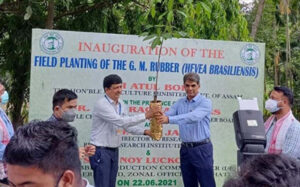India plants the world’s first genetically modified rubber plant
The world’s first genetically modified (GM) rubber plant was planted on the outskirts of Guwahati by the Chairman and Executive Director of the Rubber Board, K.N. Raghavan.
Planted at the Rubber Board’s Sarutari research farm near Guwahati, the plant was developed at the Kerala-based Rubber Research Institute of India (RRII) through long years of research at its biotechnology laboratory.
Raghavan said that the genetically modified rubber plant, the first of its kind developed exclusively for this region, is expected to grow well under the climatic conditions of the mountainous northeastern region.
The Rubber Board Chairman said that the GM rubber plant would be a game-changer in natural rubber cultivation in India, with additional copies of the gene MnSOD (manganese-containing superoxide dismutase) inserted in it.
“The GM rubber plant is expected to tide over the severe cold conditions during winter, which is a major factor affecting the growth of young rubber plants. Natural rubber is a native of warm humid Amazon forests and it is not naturally suited for the cold conditions in this part of the country,” he said.
Raghavan said that through breeding and selection, RRII, a Rubber Board research body, had earlier developed two high-yielding hybrid clones of rubber that are adapted to the climatic conditions of the northeast region.
According to the physician-turned-Indian Revenue Service officer, the growth of young rubber remains suspended during the winter months, which are also characterised by progressive drying of the soil.
“This is the reason for the long immaturity period of this crop in the region. The MnSOD gene has the ability to protect the plants from the adverse effects of severe environmental stresses such as cold, drought etc.
“Laboratory studies conducted at the RRII in Kerala’s Kottayam showed that GM rubber plants over-expressed the MnSOD gene as expected, offering protection to the cells. Therefore, it is expected that the GM rubber plants will grow fast here,” Raghavan said.
He further explained that what is planted now is not on a commercial basis, but on an experimental level following all mandatory bio-safety measures applicable to field trials involving GM crops.
He also allayed unfounded fears about GM rubber.
The MnSOD gene used in the GM rubber was taken from the rubber plant itself, he said.
“Its copies were multiplied in the laboratory and reinserted into a cell of the rubber plant which was then regenerated into a full plant that is now planted in the field.
“There are no plant species in India that can breed with natural rubber. Therefore, there is no risk of the genes flowing from the GM rubber into any other native species, a concern often raised by environmental groups against GM plants in general,” he pointed out.
Raghavan stated that the Rubber Board has attached great importance to its activities in the northeast region of India, where rubber cultivation is a potential tool for rural development and empowerment of the peasants, including the indigenous communities of the region.
The Rubber Board is actively promoting rubber cultivation in the region with financial support from the Indian tyre industry.
Its choice of Assam to plant the first GM rubber also demonstrates the importance it attaches to the region.
A senior Rubber Board official said that seven northeastern states, especially Tripura and Assam, are cultivating rubber in 1,90,000 hectares of land annually, producing 1,11,700 tonne natural rubber.
Tripura, which is the second-largest natural rubber producing state in the country after Kerala, is currently cultivating natural rubber in 85,500 hectares of land and producing 62,000 tons of rubber annually. Over 1.50 lakh families are directly and indirectly associated with rubber cultivation in the northeastern state.

